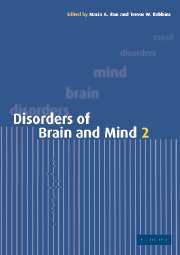Book contents
- Frontmatter
- Contents
- List of contributors
- Preface
- Part I Genes and behaviour
- Part II Brain development
- 3 Brain development: glial cells generate neurons – implications for neuropsychiatric disorders
- 4 Brain development: the clinical perspective
- Part III New ways of imaging the brain
- Part VI Imaging the normal and abnormal mind
- Part V Consciousness and will
- Part IV Recent advances in dementia
- Part VII Affective illness
- Part VIII Aggression
- Part IX Drug use and abuse
- Index
- Plate section
- References
4 - Brain development: the clinical perspective
from Part II - Brain development
Published online by Cambridge University Press: 19 January 2010
- Frontmatter
- Contents
- List of contributors
- Preface
- Part I Genes and behaviour
- Part II Brain development
- 3 Brain development: glial cells generate neurons – implications for neuropsychiatric disorders
- 4 Brain development: the clinical perspective
- Part III New ways of imaging the brain
- Part VI Imaging the normal and abnormal mind
- Part V Consciousness and will
- Part IV Recent advances in dementia
- Part VII Affective illness
- Part VIII Aggression
- Part IX Drug use and abuse
- Index
- Plate section
- References
Summary
Introduction
While the development of the brain may not at first glance appear to be relevant to psychosis, it is now widely acknowledged that schizophrenia may result from an abnormality of brain development. Although taken individually much of the evidence in support of this theory does not represent conclusive proof, an intriguing picture is emerging from a variety of approaches, including epidemiological and brain-imaging studies (reviewed by Murray and Woodruff 1995; Raedler et al. 1998). These, along with postmortem histological studies, have led to the ‘neurodevelopmental hypothesis’ of schizophrenia, which suggests that a brain abnormality is present early in life but does not fully manifest itself until late adolescence or early adulthood, perhaps following functional maturation (Weinberger 1987; Waddington 1993). However, the causes and timing of any such abnormality remain to be determined. The familial nature of schizophrenia implies that an interaction between genetic and environmental factors is likely, while the vulnerability period may extend from pregnancy to early adolescence.
There is less evidence to suggest that bipolar disorder may have a developmental aetiology. While studies of bipolar disorder are limited in number, in part due to diagnostic considerations, some shared epidemiological risk factors along with gross and microscopic pathologies have been identified (Torrey 1999). However, there are also important differences between the disorders. In this chapter evidence for a neurodevelopmental origin of both schizophrenia and bipolar disorder will be presented, along with possible implications for the timing and causes of these disorders.
- Type
- Chapter
- Information
- Disorders of Brain and Mind , pp. 74 - 92Publisher: Cambridge University PressPrint publication year: 2003

